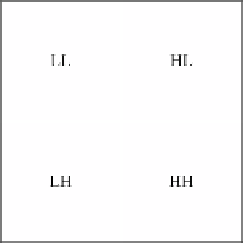Graphics Reference
In-Depth Information
apply dimensional wavelet transformation to decompose and reconstruct it with the
Mallat algorithm. First, we design a low-pass and high-pass filter according to the kinds
of wavelets. Then, we use two filter to make the convolutions with image. This way, the
image is divided into four sub-bands as Fig.3 shows.
Fig. 3.
Dimensional wavelet transform of image
Fig. 3 illustrates the result of the wavelet transformation at once.
LL
represents the
low frequency of sub-band which contains the basic information of an image, while
HL
,
LH
and
HH
represent three high frequency sub-bands. If the wavelets transforma-
tion is executed to the
LL
, it can be decomposed into other four sub-bands with smaller
scales. Continue to decompose
LL
of each sub-band will provide more sub-bands in
multi-resolutions. Thus, we can obtain some information in different frequency by
wavelet transformation.
With the above analysis, we are applying the wavelet transformation to decompose
the illumination acquired via the retinex in this essay. Then, we will set the low fre-
quency coefficients to zeros to obtain a new “illumination” by inverse transformation.
The new “illumination” can be seen as “middle frequency” in original image. At last,
invariant and the “illumination” are used to construct a face for recognizing. Here is the
detailed explanation of our method:
1)
Utilize the retinex to decompose the original image into illumination invariant and
illumination (low frequency component).
2)
Locate eyes in reflectance via the approaches in [5,6], then rotate and segment the
reflectance and illumination to aquire the effective fields according to the eye po-
sition.
3)
Decompose the illumination by the wavelet transformation and set
LL(i)
coeffi-
cients to zeros, then make the inverse transformation to acquire new “illumina-
tion”, here the
i
means the
i
th layer decomposition.
4)
Reconstruct new image according to equation (2).
The process is illustrated in Fig.4

Search WWH ::

Custom Search